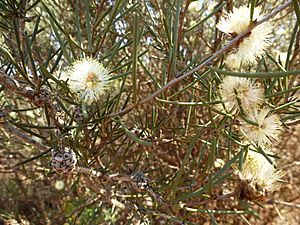Melaleuca hamata facts for kids
Quick facts for kids Melaleuca hamata |
|
|---|---|
 |
|
| M. hamata leaves, flowers and fruit | |
| Scientific classification | |
| Genus: |
Melaleuca
|
| Species: |
hamata
|
Melaleuca hamata is a special plant that belongs to the myrtle family, called Myrtaceae. It only grows naturally in the southwest part of Western Australia. This plant is a big, bushy shrub with lots of pale yellow flowers that look like a broom. It blooms in late spring.
Contents
What Melaleuca hamata Looks Like
Melaleuca hamata is usually a large bush, but sometimes it can grow into a small tree. It can reach about 5 meters (16 feet) tall. Its bark peels off in thin, papery layers.
The leaves grow one after another along the stem. They point upwards and look like needles. Each leaf can be up to 80 millimeters (about 3 inches) long. They are narrow, like a thick thread, and have a sharp tip that often hooks.
Flowers and Fruit
The flowers of Melaleuca hamata are yellow, cream, or white. They grow in round groups, almost like balls. These flower heads are found where the leaves meet the stem. Each head is about 20 millimeters (less than an inch) wide. They contain 5 to 15 small groups of three flowers each.
The petals are tiny, only 1 to 2 millimeters long. They often fall off soon after the flower opens. The bright color of the flowers comes from their many stamens. Stamens are the parts of a flower that make pollen. These stamens are grouped into five bundles around the flower. Each bundle has 3 to 8 stamens.
This plant flowers during spring and early summer. After the flowers, it produces woody fruits. These fruits are called capsules. They form oval-shaped clusters that can be up to 12 millimeters (about half an inch) wide.
How It Got Its Name
This plant was first officially described in 1844. Two scientists, Henry Barron Fielding and Charles Austin Gardner, gave it its scientific name. The second part of its name, hamata, comes from a Latin word, hamus. This word means "a hook." It refers to the hooked tips on the leaves of the plant.
Where It Grows
Melaleuca hamata is found in many different areas of Western Australia. These areas include places like Mount Gibson, Nyabing, and Leinster. It grows in many types of soil and in different plant communities. It is a very common type of "brushwood" plant in the wheatbelt region. The wheatbelt is an area where a lot of wheat is grown.
Conservation Status
Good news! The government of Western Australia says that Melaleuca hamata is "not threatened." This means there are plenty of these plants around, and they are not in danger of disappearing.
Uses of Melaleuca hamata
Farming Uses
Farmers sometimes grow different types of melaleucas to use as "brushwood." Brushwood is a type of woody plant material. In tests, Melaleuca hamata was found to be the best type of melaleuca for growing in the heavy, rich soils found in many parts of Western Australia.
Images for kids
-
M. hamata growing near Ravensthorpe



